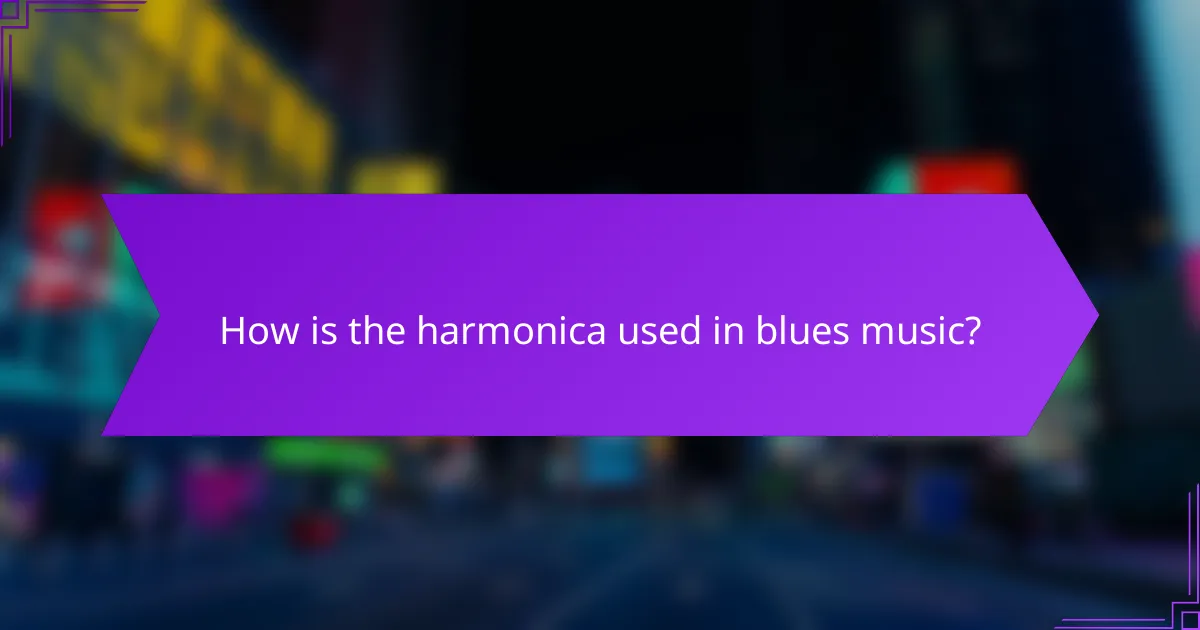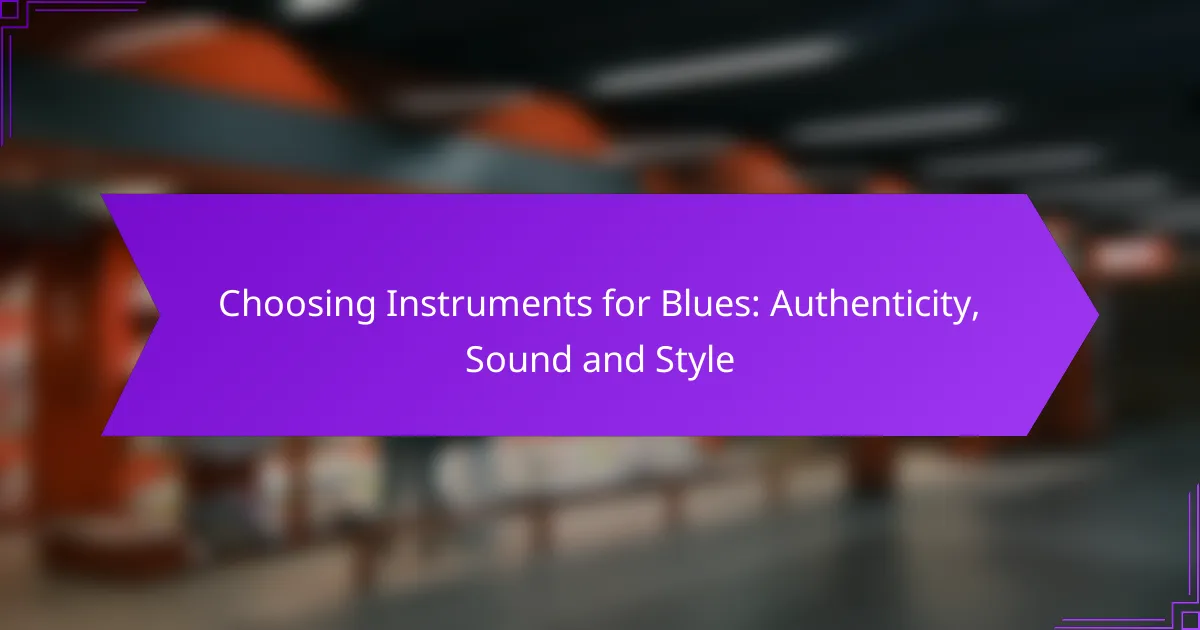The harmonica is an essential instrument in blues music, providing both melody and rhythm while allowing musicians to express profound emotions. Techniques like bending notes and vibrato enrich the sound, making the harmonica a powerful tool for conveying the genre’s emotional depth. Renowned brands such as Seydel, Hohner, and Lee Oskar offer high-quality harmonicas tailored for blues players, enhancing their musical experience.

How is the harmonica used in blues music?
The harmonica plays a vital role in blues music, serving as both a melodic and rhythmic instrument. Its expressive capabilities allow musicians to convey deep emotions and enhance the overall sound of blues compositions.
Melodic expression
The harmonica is often used to deliver soulful melodies that resonate with the emotional depth of blues music. Players utilize techniques like bending notes and vibrato to create a rich, expressive sound that captures the essence of the genre.
Commonly, harmonica solos are integrated into songs, providing a voice-like quality that complements the vocals. This instrument can evoke feelings ranging from joy to sorrow, making it a powerful tool for storytelling in blues.
Rhythmic accompaniment
In addition to melody, the harmonica serves as a rhythmic accompaniment, enhancing the groove of blues tracks. Musicians often play rhythmic patterns that support the guitar and drums, adding texture and depth to the overall sound.
Using techniques such as tongue blocking and chugging, harmonica players can create a percussive effect that drives the music forward. This rhythmic role is essential in ensemble settings, where the harmonica helps maintain the song’s pulse.
Improvisation techniques
Improvisation is a key aspect of blues music, and the harmonica allows for spontaneous creativity. Players often use scales like the blues scale to improvise solos that fit seamlessly within the song structure.
Techniques such as call-and-response, where the harmonica mimics or answers vocal lines, are common in blues improvisation. This interaction not only showcases the player’s skill but also enriches the musical dialogue between instruments and vocals.

What techniques enhance harmonica performance in blues?
Techniques such as bending notes, overblowing, and vibrato significantly enhance harmonica performance in blues music. Mastering these skills allows players to produce expressive sounds and add emotional depth to their playing.
Bending notes
Bending notes is a fundamental technique in blues harmonica playing that alters the pitch of a note by changing the shape of the mouth and airflow. This technique allows players to create a soulful, expressive sound that is characteristic of blues music.
To bend a note, draw or blow air through the harmonica while adjusting your mouth shape and tongue position. Typically, bending is most effective on draw notes, and players often practice on holes 1 to 6 to achieve the desired pitch change. Aim for a bend of about a whole step or more for a pronounced effect.
Overblowing
Overblowing is an advanced technique that enables players to access notes that are not typically available on a standard diatonic harmonica. This technique involves using a specific embouchure and breath control to create a higher pitch when drawing or blowing air.
To practice overblowing, focus on holes 6 to 10, as these are where this technique is most commonly applied. It may take time to develop the necessary control, so be patient and practice consistently. Overblowing can expand your musical range and add unique tonal qualities to your blues playing.
Vibrato
Vibrato adds a rich, dynamic quality to harmonica playing, making notes sound more expressive and alive. This technique involves varying the pitch or volume of a note in a controlled manner, typically achieved through subtle changes in breath support or mouth shape.
To develop vibrato, experiment with different speeds and depths of modulation. A common approach is to use a slight throat or diaphragm pulse while maintaining a steady airflow. Aim for a natural, fluid sound rather than a mechanical effect, and practice incorporating vibrato into your playing to enhance emotional expression in blues music.

What are the best harmonica brands for blues?
The best harmonica brands for blues are known for their quality, sound, and playability. Popular choices include Seydel, Hohner, and Lee Oskar, each offering unique features that cater to blues musicians.
Seydel Blues Session
The Seydel Blues Session harmonica is designed specifically for blues players, featuring stainless steel reeds that provide durability and a bright sound. It is available in various keys, making it versatile for different musical styles.
One notable aspect of the Blues Session is its comfortable mouthpiece, which allows for easy playing during long sessions. Additionally, the harmonica is known for its responsive action, enabling quick note changes that are essential in blues music.
Hohner Marine Band
The Hohner Marine Band is a classic choice among blues harmonica players, renowned for its rich tone and traditional wooden comb. This harmonica has been a favorite since its introduction, offering a warm sound that complements blues music beautifully.
Players appreciate the Marine Band’s ability to bend notes, a crucial technique in blues playing. It is available in multiple keys and has a distinctive shape that many find comfortable to hold while performing.
Lee Oskar Major Diatonic
The Lee Oskar Major Diatonic harmonica is celebrated for its easy playability and bright, clear sound. It features a unique design that allows for quick reed replacement, making maintenance straightforward for musicians.
This harmonica is particularly favored for its versatility across various genres, including blues. It comes in several keys and is built to withstand rigorous playing, making it a reliable choice for both beginners and seasoned players.

What is the impact of harmonica on blues culture?
The harmonica has a profound impact on blues culture, serving as a vital instrument that embodies the genre’s emotional depth and improvisational spirit. Its portability and expressive capabilities allow musicians to convey powerful feelings, making it a staple in blues music across various settings.
Influence on iconic artists
Many legendary blues artists have prominently featured the harmonica in their music, shaping the sound and style of the genre. Artists like Little Walter and Sonny Boy Williamson transformed the harmonica into a lead instrument, influencing countless musicians and establishing its place in blues history.
The harmonica’s unique sound has allowed artists to create signature styles, contributing to the development of subgenres such as Chicago blues and Delta blues. Its role in their music highlights the instrument’s versatility and emotional resonance.
Role in blues festivals
Harmonica performances are a central attraction at blues festivals, showcasing both established and emerging talent. These events often feature harmonica competitions, where musicians demonstrate their skills and creativity, fostering a sense of community among blues enthusiasts.
Festivals provide a platform for harmonica players to collaborate with other musicians, enhancing the overall experience for attendees. This interaction not only promotes the instrument but also helps preserve the rich traditions of blues music.
Contribution to blues evolution
The harmonica has played a crucial role in the evolution of blues, adapting to changing musical styles and influences. Its integration into rock and folk music has expanded its reach, introducing new audiences to the blues genre.
As artists experiment with different techniques and sounds, the harmonica continues to evolve, ensuring its relevance in contemporary music. This adaptability highlights the instrument’s enduring significance in the blues landscape.

How to choose a harmonica for blues playing?
Choosing a harmonica for blues involves selecting the right type, understanding key features, and considering your budget. The ideal harmonica should facilitate expressive playing and suit your musical style.
Key selection
When selecting a harmonica for blues, focus on key compatibility with the songs you intend to play. Common keys for blues harmonicas include C, A, and D, as they align well with popular blues progressions. A harmonica in the key of C is often recommended for beginners due to its versatility.
Consider the tuning system as well; diatonic harmonicas are the standard choice for blues, allowing for bending notes and expressive techniques. Ensure that the harmonica is comfortable to hold and play, as this will enhance your overall experience.
Type of harmonica
The most suitable type of harmonica for blues is the diatonic harmonica, which typically has ten holes and is designed for single-note playing. Brands like Hohner and Lee Oskar offer reliable models that are popular among blues musicians. For more advanced players, chromatic harmonicas can also be used, but they require a different playing technique.
Consider the reed material as well; brass reeds provide a warm tone, while stainless steel reeds offer durability. Each type has its own sound characteristics, so it’s beneficial to try different options to find what resonates with your style.
Budget considerations
Your budget can significantly influence your harmonica choice. Entry-level diatonic harmonicas typically range from $30 to $50, while professional models can cost upwards of $100. It’s wise to invest in a quality instrument that will last, especially if you plan to play regularly.
Keep in mind that additional costs may arise from accessories like cases, cleaning supplies, and instructional materials. Setting aside a budget for these items can enhance your playing experience and help maintain your harmonica in good condition.



